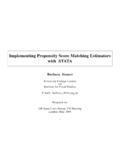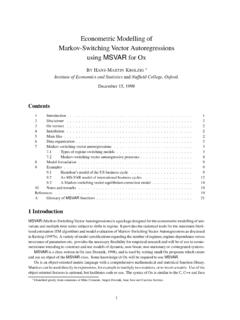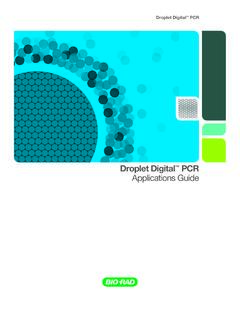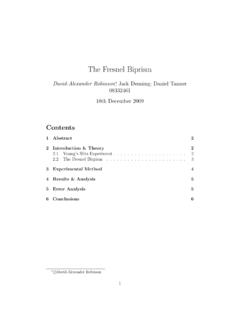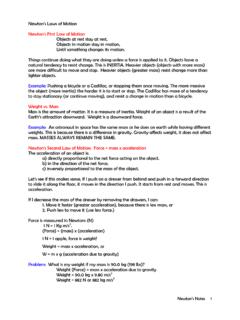Transcription of Instrumental variables and panel data methods in economics ...
1 Instrumental variables and panel data methods in economics and finance Christopher F Baum Boston College and DIW Berlin February 2009. Christopher F Baum (Boston College) IVs and panel Data Feb 2009 1 / 43. Instrumental variables estimators Regression with Instrumental variables What are Instrumental variables (IV) methods ? Most widely known as a solution to endogenous regressors: explanatory variables correlated with the regression error term, IV methods provide a way to nonetheless obtain consistent parameter estimates. Although IV estimators address issues of endogeneity, the violation of the zero conditional mean assumption caused by endogenous regressors can also arise for two other common causes: measurement error in regressors (errors-in- variables ) and omitted-variable bias.
2 The latter may arise in situations where a variable known to be relevant for the data generating process is not measurable, and no good proxies can be found. Christopher F Baum (Boston College) IVs and panel Data Feb 2009 2 / 43. Instrumental variables estimators Regression with Instrumental variables What are Instrumental variables (IV) methods ? Most widely known as a solution to endogenous regressors: explanatory variables correlated with the regression error term, IV methods provide a way to nonetheless obtain consistent parameter estimates. Although IV estimators address issues of endogeneity, the violation of the zero conditional mean assumption caused by endogenous regressors can also arise for two other common causes: measurement error in regressors (errors-in- variables ) and omitted-variable bias.
3 The latter may arise in situations where a variable known to be relevant for the data generating process is not measurable, and no good proxies can be found. Christopher F Baum (Boston College) IVs and panel Data Feb 2009 2 / 43. Instrumental variables estimators First let us consider a path diagram illustrating the problem addressed by IV methods . We can use ordinary least squares (OLS) regression to consistently estimate a model of the following sort. Standard regression: y = xb + u no association between x and u; OLS consistent x - y . *.. u Christopher F Baum (Boston College) IVs and panel Data Feb 2009 3 / 43. Instrumental variables estimators However, OLS regression breaks down in the following circumstance: Endogeneity: y = xb + u correlation between x and u; OLS inconsistent x - *.
4 Y 6 .. u The correlation between x and u (or the failure of the zero conditional mean assumption E[u|x] = 0) can be caused by any of several factors. Christopher F Baum (Boston College) IVs and panel Data Feb 2009 4 / 43. Instrumental variables estimators However, OLS regression breaks down in the following circumstance: Endogeneity: y = xb + u correlation between x and u; OLS inconsistent x - *.. y 6 .. u The correlation between x and u (or the failure of the zero conditional mean assumption E[u|x] = 0) can be caused by any of several factors. Christopher F Baum (Boston College) IVs and panel Data Feb 2009 4 / 43. Instrumental variables estimators Endogeneity Endogeneity We have stated the problem as that of endogeneity: the notion that two or more variables are jointly determined in the behavioral model.
5 This arises naturally in the context of a simultaneous equations model such as a supply-demand system in economics , in which price and quantity are jointly determined in the market for that good or service. A shock or disturbance to either supply or demand will affect both the equilibrium price and quantity in the market, so that by construction both variables are correlated with any shock to the system. OLS. methods will yield inconsistent estimates of any regression including both price and quantity, however specified. Christopher F Baum (Boston College) IVs and panel Data Feb 2009 5 / 43. Instrumental variables estimators Endogeneity Endogeneity We have stated the problem as that of endogeneity: the notion that two or more variables are jointly determined in the behavioral model.
6 This arises naturally in the context of a simultaneous equations model such as a supply-demand system in economics , in which price and quantity are jointly determined in the market for that good or service. A shock or disturbance to either supply or demand will affect both the equilibrium price and quantity in the market, so that by construction both variables are correlated with any shock to the system. OLS. methods will yield inconsistent estimates of any regression including both price and quantity, however specified. Christopher F Baum (Boston College) IVs and panel Data Feb 2009 5 / 43. Instrumental variables estimators Endogeneity As a different example, consider a cross-sectional regression of public health outcomes (say, the proportion of the population in various cities suffering from a particular childhood disease) on public health expenditures per capita in each of those cities.
7 We would hope to find that spending is effective in reducing incidence of the disease, but we also must consider the reverse causality in this relationship, where the level of expenditure is likely to be partially determined by the historical incidence of the disease in each jurisdiction. In this context, OLS estimates of the relationship will be biased even if additional controls are added to the specification. Although we may have no interest in modeling public health expenditures, we must be able to specify such an equation in order to identify the relationship of interest, as we discuss henceforth. Christopher F Baum (Boston College) IVs and panel Data Feb 2009 6 / 43. Instrumental variables estimators Endogeneity As a different example, consider a cross-sectional regression of public health outcomes (say, the proportion of the population in various cities suffering from a particular childhood disease) on public health expenditures per capita in each of those cities.
8 We would hope to find that spending is effective in reducing incidence of the disease, but we also must consider the reverse causality in this relationship, where the level of expenditure is likely to be partially determined by the historical incidence of the disease in each jurisdiction. In this context, OLS estimates of the relationship will be biased even if additional controls are added to the specification. Although we may have no interest in modeling public health expenditures, we must be able to specify such an equation in order to identify the relationship of interest, as we discuss henceforth. Christopher F Baum (Boston College) IVs and panel Data Feb 2009 6 / 43. Instrumental variables estimators Endogeneity The solution provided by IV methods may be viewed as: Instrumental variables regression: y = xb + u z uncorrelated with u, correlated with x z - x - y 6.
9 *.. u The additional variable z is termed an instrument for x. In general, we may have many variables in x, and more than one x correlated with u. In that case, we shall need at least that many variables in z. Christopher F Baum (Boston College) IVs and panel Data Feb 2009 7 / 43. Instrumental variables estimators Choice of instruments Choice of instruments To deal with the problem of endogeneity in a supply-demand system, a candidate z will affect ( ) the quantity supplied of the good, but not directly impact the demand for the good. An example for an agricultural commodity might be temperature or rainfall: clearly exogenous to the market, but likely to be important in the production process. For the public health example, we might use per capita income in each city as an instrument or z variable.
10 It is likely to influence public health expenditure, as cities with a larger tax base might be expected to spend more on all services, and will not be directly affected by the unobserved factors in the primary relationship. Christopher F Baum (Boston College) IVs and panel Data Feb 2009 8 / 43. Instrumental variables estimators Choice of instruments Choice of instruments To deal with the problem of endogeneity in a supply-demand system, a candidate z will affect ( ) the quantity supplied of the good, but not directly impact the demand for the good. An example for an agricultural commodity might be temperature or rainfall: clearly exogenous to the market, but likely to be important in the production process. For the public health example, we might use per capita income in each city as an instrument or z variable.






